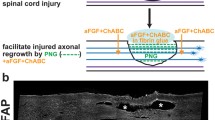Abstract
A recent study of a rat model treated with grafted collagen filament (CF) after spinal cord transection showed dramatic recovery of motor function but did not report on the acute-stage phenomenon. In the present study, we describe molecular and histological aspects of the axonal regeneration process during the acute stage following spinal cord transection. The spinal cord of 8-week-old rats was completely transected, and a scaffold of almost the same size as the resected portion was implanted in the gap. Changes in the mRNA expression of four neurotrophic factors [nerve growth factor (NGF), brain-derived neurotrophic factor (BDNF), NT-3, and glial cell-derived neurotrophic factor (GDNF)] were analyzed after 72 h. The expression of BDNF and NT-3 mRNA increased significantly in the CF-grafted group compared to the nongrafted group. Immunostaining for BDNF and NT-3 revealed that cells positive for these neurotrophic factors extended along the collagen filaments in the CF-grafted group. Similarly, astrocytes extended into the collagen filament scaffold together with the neurotrophic factors and partly across a border line. These findings indicate that collagen filament helps to reduce scar tissue, supports the expression of neurotrophic factors, and serves as a scaffold for the outgrowth of regenerating axons.
Similar content being viewed by others
References
Yoshii S, Oka M, Shima M, Akagi M, Taniguchi A (2003) Bridging a spinal cord defect using collagen filament. Spine 28(20): 2346–2351
Galabov G (1966) Regeneration of sectioned spinal cord by implantation of a peripheral nerve. C R Acad Bulg Sci 19:449–452
Nygren L, Olson L, Seiger A (1977) Monoaminergic reinnervation of the transected spinal cord by homologous fetal brain grafts. Brain Res 129:227–235
de la Torre JC (1982) Catecholamine fiber regeneration across a collagen bioimplant after spinal cord transection. Brain Res Bull 9:545–552
Nakamura M, Houghtling RA, MacArthur L (2003) Difference in cytokine gene expression profile between acutely and chronically injured adult rat spinal cord. Exp Neurol 184:313–325
Suzuki H, Taguchi T, Tanaka H (2004) Neurospheres induced from bone marrow stromal cells are multipotent for differentiation into neuron, astrocyte, and oligodendrocyte phenotype. Biochem Biophys Res Commun 322:918–922
Kasahara K, Nakagawa T, Kubota T (2006) Neuronal loss and expression of neurotrophic factors in a model of rat chronic compressive spinal cord injury. Spine 31(18):2059–2066
Stokols S, Tuszynski MH (2006) Freeze-dried agarose scaffolds with uniaxial channels stimulate and guide linear axonal growth following spinal cord injury. Biomaterials 27:443–445
Michael J, Jonathan A (2006) Multiple-channel scaffolds to promote spinal cord axon regeneration. Biomaterials 27:419–429
Kataoka K, Suzuki Y, Kitada M (2004) Alginate enhances elongation of early regenerating axons in spinal cord of young rat. Tissue Eng 10:493–504
Xiao-Li LA, Wei ZB, Xue Z (2007) Temporal changes in the expression of some neurotrophins in spinal cord transected adult rats. Neuropeptides 41:135–143
Sariola H, Sainio K, Arumae U, Saarma M (1994) Neurotrophins and ciliary neurotrophic factor: their biology and pathology. Ann Med 26:355–363
Jakeman LB, Wei P, Guan Z, Stokes B (1998) Brain-derived neurotrophic factor stimulates hindlimb stepping and sprouting of cholinergic fibers after spinal cord injury. Exp Neurol 154:170–184
Zhou L, Shine H (2003) Neurotrophic factors expressed in both cortex and spinal cord induce axonal plasticity after spinal cord injury. J. Neurosci Res 74:221–226
Gulino R, Lombardo SA, Casabona A, Leanza G, Perciavalle V (2004) Levels of brain-derived neurotrophic factor and neurotrophin-4 in lumbar motoneurons after low-thoracic spinal cord hemisection. Brain Res 1013:174–181
Gomez-Pinilla F, Ying Z, Opazo P, Roy R, Edgerton VR (2001) Differential regulation by exercise of BDNF and NT-3 in rat spinal cord and skeletal muscle. Eur J Neurosci 13:1078–1084
James M, Mariano S (2007) Increased chondroitin sulfate proteoglycan expression in denervated brainstem targets following spinal cord injury creates a barrier to axonal regeneration overcome by chondroitinase ABC and neurotrophin-3. Exp Neurol 209(2):426–445
Iseda T, Nishio T, Kawaguchi T (2004) Spontaneous regeneration of the corticospinal tract after transaction in young rats. Neuroscience 126:365–374
Silver J, Ogawa MY (1983) Postnatally induced formation of the corpus callosum in acallosal mice on glia-coated cellulose bridges. Science 220:1067–1069
Author information
Authors and Affiliations
Corresponding author
Rights and permissions
About this article
Cite this article
Yara, T., Kato, Y., Kataoka, H. et al. Environmental factors involved in axonal regeneration following spinal cord transection in rats. Med Mol Morphol 42, 150–154 (2009). https://doi.org/10.1007/s00795-009-0454-y
Received:
Accepted:
Published:
Issue Date:
DOI: https://doi.org/10.1007/s00795-009-0454-y




